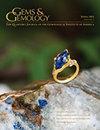蒙大拿州Yogo Gulch蓝宝石的宝石学特征
IF 1.6
3区 地球科学
Q2 MINERALOGY
引用次数: 5
摘要
蒙大拿州的Gulch生产了数百万克拉的毛坯蓝宝石。其中大部分都产生了非常小的成品石头,超过1克拉的刻面石头非常珍贵(图1)。已知最大的Yogo蓝宝石晶体于1910年被发现,重达19 ct(Howard,1962a)。Yogo毛坯的形状通常是扁平的片状晶体,产率非常低。超过1克拉的大石头几乎完全是收藏石,其来源对价值有重大影响。虽然蒙大拿州还有其他重要的宝石级蓝宝石来源,包括Rock Creek、密苏里河和Dry Cottonwood Creek,但Yogo蓝宝石在这些和世界各地的其他蓝宝石矿床中是独一无二的(图2)。几乎所有生产的材料都具有理想的蓝色到紫色或紫色,通常比其他矿床的蓝宝石清晰度更高(Yaras,1969)(图3)。Yogo蓝宝石不需要热处理,这实际上保证了其未经处理的性质。它们还具有独特的微量元素化学成分和一套内含物,这使得经验丰富的宝石学家很容易识别它们。历史1895年,一位名叫杰克·胡佛的金矿勘探者意外发现了Yogo蓝宝石矿床。胡佛向两位朋友寻求资金支持——当地银行家S.S.Hobson和芝加哥兽医Jim Bouvet博士——三人建立了采矿合作伙伴关系。在从他的本文章由计算机程序翻译,如有差异,请以英文原文为准。
Gemological Characterization of Sapphires from Yogo Gulch, Montana
Gulch, Montana, have produced millions of carats of rough sapphire. Much of that has yielded very small finished stones, and faceted stones over 1 ct are highly prized (figure 1). The largest known Yogo sapphire crystal was found in 1910 and weighed 19 ct (Howard, 1962a) The shape of Yogo rough is often in the form of flat tabular crystals that offer a very low yield. Large stones over 1 ct are almost exclusively collector stones, with the provenance having a significant impact on value. While there are other significant sources of gem-quality sapphire in Montana—including Rock Creek, Missouri River, and Dry Cottonwood Creek—Yogo sapphires are unique among these and other sapphire deposits worldwide (figure 2). Virtually all of the material produced has a desirable even blue to violet or purple color, often with higher clarity than sapphires from other deposits (Yaras, 1969) (figure 3). Yogo sapphires do not require heat treatment, offering a virtual guarantee of their untreated nature. They also possess a unique trace-element chemistry and an inclusion suite that makes them easily recognizable to the experienced gemologist. HISTORY In 1895, the Yogo sapphire deposit was accidentally discovered by a gold prospector named Jake Hoover. Hoover sought financial backing from two friends— local banker S.S. Hobson and Dr. Jim Bouvet, a veterinarian from Chicago—and the three formed a mining partnership. While recovering gold from his
求助全文
通过发布文献求助,成功后即可免费获取论文全文。
去求助
来源期刊

Gems & Gemology
地学-矿物学
CiteScore
2.90
自引率
19.20%
发文量
10
期刊介绍:
G&G publishes original articles on gem materials and research in gemology and related fields. Manuscript topics include, but are not limited to:
Laboratory or field research;
Comprehensive reviews of important topics in the field;
Synthetics, imitations, and treatments;
Trade issues;
Recent discoveries or developments in gemology and related fields (e.g., new instruments or identification techniques, gem minerals for the collector, and lapidary techniques);
Descriptions of notable gem materials and localities;
Jewelry manufacturing arts, historical jewelry, and museum exhibits.
 求助内容:
求助内容: 应助结果提醒方式:
应助结果提醒方式:


